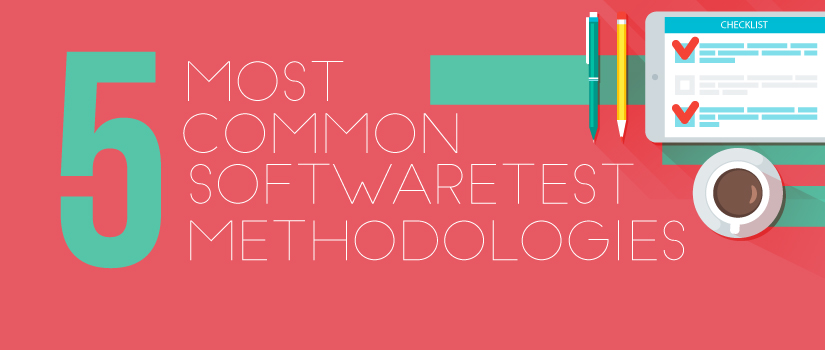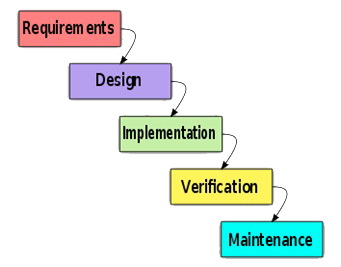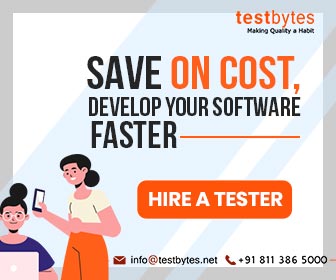
5 Most Common Software Testing Methodologies
June 8th, 2015

Software testing services offer a number of testing models. But for you to choose the right testing model, you need to be aware of the capabilities and shortcomings of each model. In this blog, we help you to choose the testing methodologies that best suits your software testing needs.

Various approaches are used by software testers in software development processes. A software development process is also called a Software Development Life Cycle (SDLC). Here we will discuss 5 of the most frequently used testing methodologies and the advantages and disadvantages of using them in a Software Development Life Cycle.
1. Waterfall Model
Developed by Winston Royce in the early 1970s, it is one of the most basic life cycle models. It was the first successful process model with a sequential development phase. The process flows progressively like that of a waterfall through multiple phases and hence the name waterfall model. The model as such is divided in into the following phases:
- Requirement Gathering and Analysis phase
- Software Design
- Implementation and Testing
- Maintenance
All the phases are sequential and each step is dependent on the previous one. This means that for a particular phase to begin, all the defined set of objectives and goals belonging to the previous step needs to be completed. This can sometimes become a disadvantage, but the simplicity in implementation and ease of maintenance is what fuels the popularity of this model.
The amount of resources required is minimal when compared to other models. A document is created after every phase of the model which helps to better understand and design the system. Creating deadlines for each stage helps to develop the system within a predetermined time frame. This model is rigid and lacks flexibility. It is impossible to make changes in the development of the system.
Advantage
- Simple and easy
- Since the model is rigid, it’s easy to manage
- Clearly defined
- Minimum client intervention
- The only completion can lead to the next phase
Disadvantage
- Can’t be used for a complex project
- Highly risky
- Not meant for big projects
- Changes in the project are not possible
2. V-Model
To overcome the disadvantages of the Waterfall Model, an alternative called V Model was introduced. It enables testing at each phase of SDLC, while the Waterfall Model supports testing only in the end phase. This helped testers to find issues at the earlier stages rather than at the end.
Before the start of actual testing, the testing team works on various activities like preparing the Test Strategy, Test Planning, Creation of Test cases and Test Scripts. These work in parallel with the development activity, helping to get the test completed on time. It is also called the verification or validation model.

In this process, the “Do-Procedure” is handled by the developer team whereas the “Check-Procedure” is followed by the testing team to meet the requirements. The V-model typically consists of the following phases:
1. Unit Testing: Preparation of Unit Test Cases
2. Integration Testing: Preparation of Integration Test Cases
3. System Testing: Preparation of System test cases
4. Acceptance Testing: Preparation of Acceptance Test Cases
Advantage
- Systematic progress
- Extensive functional area coverage
- Works for small projects
- High usage of resources
- Detailed information about the problem with the software
Disadvantage
- The process comes to an abrupt end when the project is finished, in short, re-usability is less
- Not suitable for big projects
- Risk management and risk mitigation is not possible
- Not suitable if there is frequent change in requirement
3. Agile Model
The agile development model is a type of incremental model where the software is developed in incremental, rapid cycles. This produces small incremental releases with each release building on previous functionality. These releases are thoroughly tested to ensure software equality and the model is commonly used for time-critical applications.
It helps in the rapid and continuous delivery of useful software which ensures customer satisfaction. This model promotes constant interaction between customers, developers, and testers, and even facilitates face-to-face conversation.
Such a model demands a clear cut idea about the output or else the project can easily be taken off track. It is difficult for a newbie programmer and constantly requires the services of an experienced hand.
Agile welcomes changes that need to be implemented. This can be done at an affordable cost because of frequent increments that are produced. Unlike the waterfall model, the agile model requires very limited planning to get started with the project.
Advantage
- Rapid continuous delivery
- Changes in requirement will not be an issue
- Concentration on the process
- More focus on customer satisfaction
Disadvantage
- Lengthy documentation
- Cannot be used for small projects
- If the customer is not sure about the project it can derail
- Only experienced testers can be a part of the process
4. Spiral Model
It is similar to the incremental model but gives more emphasis on risk analysis. The spiral model has four phases:
- Planning
- Risk Analysis
- Engineering
- Evaluation.
A software project repeatedly goes through these phases in iterations and in the baseline spiral, starting in the planning phase, requirements are gathered and risk is analyzed. Each subsequent spiral builds on the baseline spiral.
There is a high amount of risk analysis taking place which helps to better avoid them. Additional functionalities can be added at a later stage of development. In spite of the advantages, this is a costly model to use and also the process of risk analysis requires highly specific expertise.
This model is widely used when costs and risk evaluation is of prime importance, especially in those medium to high-risk projects. For users who are unsure of what they need, this model can be quite helpful.
Advantages
- Scope for extensive risk analysis
- High documentation control
- Accurate capturing of requirement
- User can see the system clearly
Disadvantages
- So complex
- End of the project will not be known early
- Only experts can do risk management
- Objectives are hard to define
- Can’t be practiced for small projects
5. RUP
It is an object-oriented and web-enabled program development methodology and is like an online mentor that provides guidelines, templates, and examples for all aspects and stages of program development. RUP is a comprehensive software engineering tool that combines the procedural aspects of development with other components of development within a unifying framework.
Advantage
- An iterative process which is better than the waterfall model in many processes
- Accurate documentation
- Integration requires less time
Disadvantage
- Relies heavily on experts
- Complicated model
- Since the process welcomes integration, it can lead to confusions

RUP establishes four phases of development:
· Inception phase: Developers define the scope of the project and its business.
· Elaboration phase: Developers analyze the project’s needs in greater detail and define its architectural foundation.
· Construction phase: Developers create the application design and source code.
· Transition phase: Developers deliver the system to users.


 Software Testing Events
Software Testing Events App Testing
App Testing Web App Testing
Web App Testing Game Testing
Game Testing Automation Testing
Automation Testing Load Testing
Load Testing Security Testing
Security Testing Performance Testing
Performance Testing Hire a Tester
Hire a Tester





